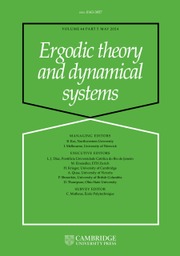Article contents
Conjugation between circle maps with several break points
Published online by Cambridge University Press: 21 July 2015
Abstract
Let  $f$ and
$f$ and  $g$ be two class
$g$ be two class  $P$ -homeomorphisms of the circle
$P$ -homeomorphisms of the circle  $S^{1}$ with break point singularities, which are differentiable maps except at some singular points where the derivative has a jump. Assume that
$S^{1}$ with break point singularities, which are differentiable maps except at some singular points where the derivative has a jump. Assume that  $f$ and
$f$ and  $g$ have irrational rotation numbers and the derivatives
$g$ have irrational rotation numbers and the derivatives  $\text{Df}$ and
$\text{Df}$ and  $\text{Dg}$ are absolutely continuous on every continuity interval of
$\text{Dg}$ are absolutely continuous on every continuity interval of  $\text{Df}$ and
$\text{Df}$ and  $\text{Dg}$ , respectively. We prove that if the product of the
$\text{Dg}$ , respectively. We prove that if the product of the  $f$ -jumps along all break points of
$f$ -jumps along all break points of  $f$ is distinct from that of
$f$ is distinct from that of  $g$ then the homeomorphism
$g$ then the homeomorphism  $h$ conjugating
$h$ conjugating  $f$ and
$f$ and  $g$ is a singular function, i.e. it is continuous on
$g$ is a singular function, i.e. it is continuous on  $S^{1}$ , but
$S^{1}$ , but  $\text{Dh}(x)=0$ almost everywhere with respect to the Lebesgue measure. This result generalizes previous results for one and two break points obtained by Dzhalilov, Akin and Temir, and Akhadkulov, Dzhalilov and Mayer. As a consequence, we get in particular Dzhalilov–Mayer–Safarov’s theorem: if the product of the
$\text{Dh}(x)=0$ almost everywhere with respect to the Lebesgue measure. This result generalizes previous results for one and two break points obtained by Dzhalilov, Akin and Temir, and Akhadkulov, Dzhalilov and Mayer. As a consequence, we get in particular Dzhalilov–Mayer–Safarov’s theorem: if the product of the  $f$ -jumps along all break points of
$f$ -jumps along all break points of  $f$ is distinct from
$f$ is distinct from  $1$ , then the invariant measure
$1$ , then the invariant measure  $\unicode[STIX]{x1D707}_{f}$ is singular with respect to the Lebesgue measure.
$\unicode[STIX]{x1D707}_{f}$ is singular with respect to the Lebesgue measure.
Information
- Type
- Research Article
- Information
- Copyright
- © Cambridge University Press, 2015
References
- 2
- Cited by

